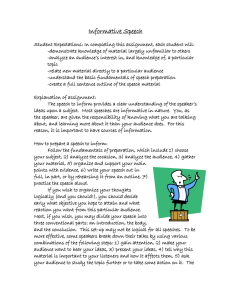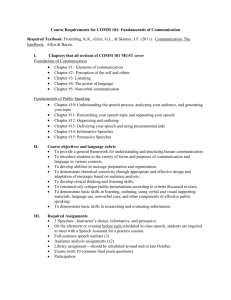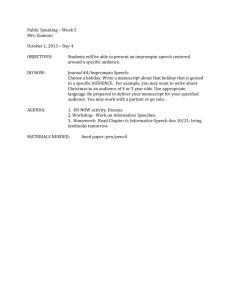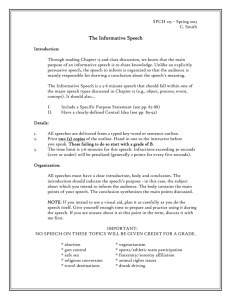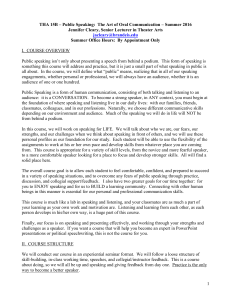Study Guide Exam 2 for COM 1010 - Ross - COM1010-1
advertisement
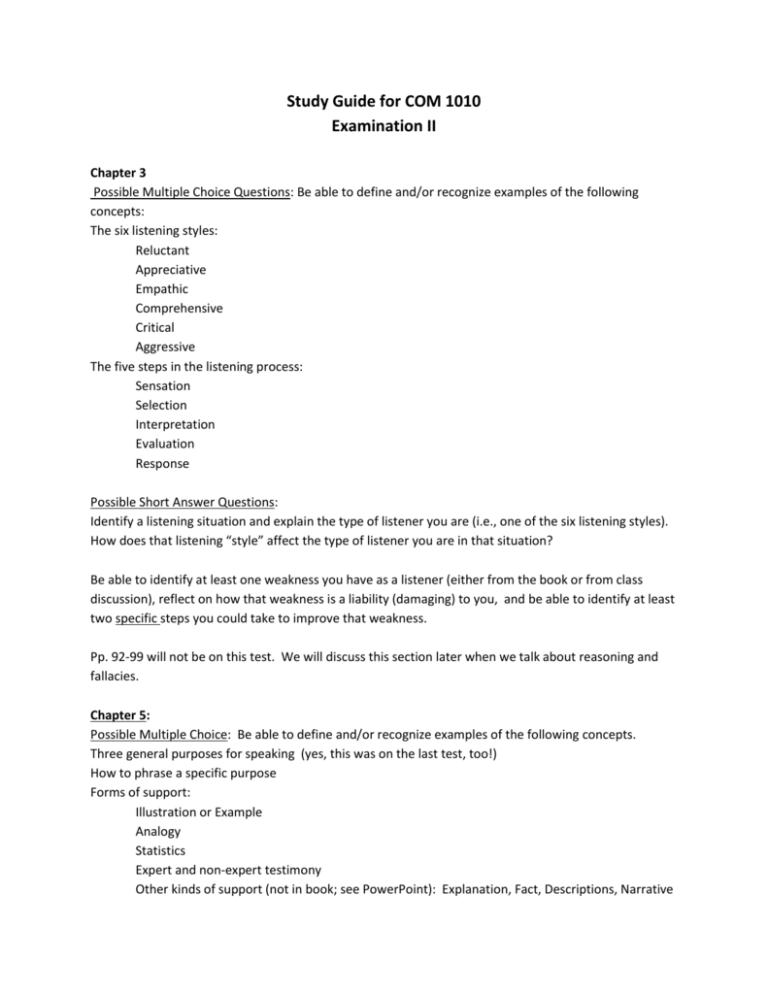
Study Guide for COM 1010 Examination II Chapter 3 Possible Multiple Choice Questions: Be able to define and/or recognize examples of the following concepts: The six listening styles: Reluctant Appreciative Empathic Comprehensive Critical Aggressive The five steps in the listening process: Sensation Selection Interpretation Evaluation Response Possible Short Answer Questions: Identify a listening situation and explain the type of listener you are (i.e., one of the six listening styles). How does that listening “style” affect the type of listener you are in that situation? Be able to identify at least one weakness you have as a listener (either from the book or from class discussion), reflect on how that weakness is a liability (damaging) to you, and be able to identify at least two specific steps you could take to improve that weakness. Pp. 92-99 will not be on this test. We will discuss this section later when we talk about reasoning and fallacies. Chapter 5: Possible Multiple Choice: Be able to define and/or recognize examples of the following concepts. Three general purposes for speaking (yes, this was on the last test, too!) How to phrase a specific purpose Forms of support: Illustration or Example Analogy Statistics Expert and non-expert testimony Other kinds of support (not in book; see PowerPoint): Explanation, Fact, Descriptions, Narrative Possible Short Answer Questions: Review pp. 145-157 on how to gather materials for your speech. Specifically: What are some proper behaviors (i.e., good etiquette) for interviewing someone on your speech topic? What is a good “rule of thumb” for evaluating internet research, especially when reviewing unverifiable sources? (see bottom of p. 153). Using a topic like “Trevecca,” or “pets” or “television” (choose one), be able to give a specific purpose and central idea (thesis sentence) that is suitable for each of the three general speaking purposes. Chapter 8 Possible Multiple Choice Questions: Be able to define and/or recognize examples of the following concepts: Delivery (“not what you say, but how you say it!”) Four types of delivery: Manuscript Memory Impromptu Extemporaneous (Also reflect on the difficulties associated with each of these types of delivery) Kinesics (body action communication) Gestures Emblem (see p. 253) Paralanguage Appropriate speaking rate (faster than 140 wpm; slower than 185—according to text). Vocal Quality Articulation (ability to make sounds with your mouth) – effective use of the mouth, lips, and tongue to make sounds Pronunciation: act of expressing words so they are understandable and conform to acceptable standards Object language Proxemics Chronemics Possible Short Answer Questions: Be able to critique a speaker’s delivery, based on a short film-clip of a speaker. Be prepared to not only identify the speaker’s weaknesses, but also to give constructive feedback on how he/she can improve delivery. Chapter 9: Possible Multiple Choice Questions: Be able to define and/or recognize examples of the following concepts: Review the suggestions for preparing visual aids on p. 278-282 and in the PowerPoint presentation on visual aids (they’re very similar). Most of the material in this chapter was also in the PowerPoint presentations we discussed in class. Review the Six common PowerPoint mistakes (PowerPoint presentation). From that, be able to explain: The “666 rule” The “rule of thumb” for deciding how many slides are needed in a presentation. Murphy’s Law as it relates to visual aids. Be prepared to evaluate a speaker’s use of a visual aid. What could he or she do differently? Chapter 10: Possible Multiple Choice Questions: Be able to define and/or recognize examples of the following concepts: Three types of informative speech (according to the text): Reporting Instructing Explaining Learning principles common to informative speaking: (Be able to recognize examples): From the known to the unknown Serial learning Reinforcement and emphasis The ideal number of repetitions in a speech (three repetitions) – p. 298 Clarity From the PowerPoint on Informative Speaking (Ch. 10) : Be able to give an example of a speech topic that would be suitable for each of these categories: Speeches about a person or people Speeches about ideas Speeches about objects Speeches about procedures Speeches about events Speeches about places Speeches about conditions Possible Short Answer Questions: Reflect on how you can develop interest in a specific topic of your choice (for example, your informative speech topic): How might you use specificity, conflict, novelty, curiosity, immediacy, vital concerns, and/or humor (or some combination of these) to make your speech interesting to the audience?
